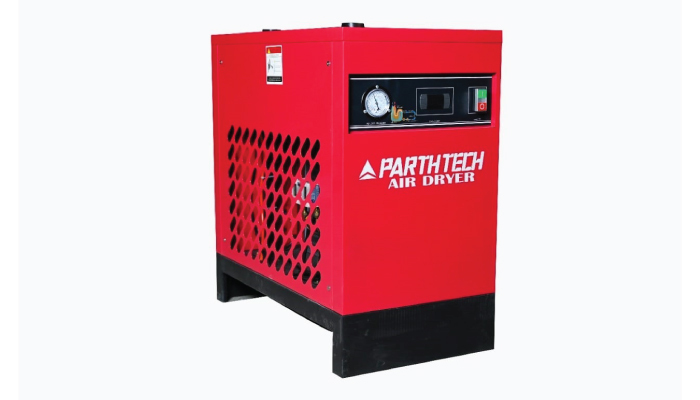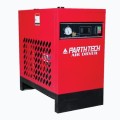-
Call
-
Whatsapp
9825014048
-
Location


Refrigerated/Heatless Air Dryer
Refrigerated/Heatless Air Dryer
Application: Automotive Industry, Food and Beverage Processing, Medical and Healthcare, Electronics Manufacturing, Dental and Medical Clinics, Laboratories.
A refrigerated/heatless air dryer is a type of compressed air treatment equipment designed to remove moisture and humidity from compressed air systems.
The "heatless" part indicates that it doesn't require external heat for regeneration, making it energy-efficient.
Refrigerated/Heatless Air Dryer
Compressed air is often referred to as the "fourth utility" due to its widespread use in various industries. It powers tools, operates machinery, and plays a critical role in countless processes. However, the air we breathe, when compressed, carries moisture, which can cause significant issues if not properly managed. Refrigerated air dryers are essential components of compressed air systems, designed to combat these challenges and ensure the delivery of clean, dry air.
How Refrigerated Air Dryers Work
The fundamental principle behind refrigerated air dryers is relatively simple yet highly effective. These dryers work by cooling the compressed air to a temperature at which moisture condenses into liquid form. This condensed moisture is then efficiently separated from the compressed air stream, leaving behind clean and dry air.
The Importance of Refrigerated Air Dryers
Refrigerated air dryers are indispensable for several reasons:
- Equipment Longevity and Protection: Moisture can accelerate corrosion and damage pneumatic equipment.
- Product Quality Assurance: In industries like food and beverage, pharmaceuticals, and electronics manufacturing, maintaining dry air is essential to ensure product quality.
- Energy Efficiency: Dry air is easier to compress, reducing the energy consumption of compressed air systems.
Choosing the Right Refrigerated Air Dryer
Selecting the appropriate refrigerated air dryer for your specific needs involves considering factors such as flow rate, capacity, dew point requirements, and the operating environment, including temperature and humidity conditions.
Installation and Maintenance
Proper installation and routine maintenance are essential to ensure the efficient operation of refrigerated air dryers. Following manufacturer guidelines and conducting regular checks are key to their longevity and reliability.
Features of Refrigerated/Heatless Air Dryer
Refrigerated air dryers offer several features that make them essential for compressed air systems:
- Temperature Control:Precise temperature control to achieve the desired dew point.
- Energy-Efficient Operation:Energy-saving designs to reduce operational costs. Reliable Dew Point Performance: Consistent performance in maintaining low dew points.
- Minimal Maintenance: Low-maintenance components and designs for hassle-free operation.
- Compact and Modular Designs::Space-saving configurations suitable for various installation environments.
| Model | Capacity CFM |
Pressure Kg/CM 2G |
| RFG - 20 | 20 | 12.3 |
| RFG - 40 | 40 | 12.3 |
| RFG - 60 | 60 | 12.3 |
| RFG - 80 | 80 | 12.3 |
| RFG - 100 | 100 | 12.3 |
| RFG - 125 | 125 | 12.3 |
| RFG - 150 | 150 | 12.3 |
| RFG - 200 | 200 | 12.3 |
| RFG - 250 | 250 | 12.3 |
| RFG - 300 | 300 | 12.3 |
| RFG - 400 | 400 | 12.3 |
| RFG - 500 | 500 | 12.3 |
| RFG - 600 | 600 | 12.3 |
| RFG - 750 | 750 | 12.3 |
| RFG - 1000 | 1000 | 12.3 |


FAQs

Frequently Ask Questions
A refrigerator air dryer is a device that removes moisture and impurities from compressed air, ensuring that it is clean and dry. It is important for compressed air because moisture in the compressed air can damage equipment and affect the process.
Refrigerated air dryers use cooling and condensation to remove water, making them energy efficient and suitable for a variety of applications. Other types, such as dry dryers, use a drying process.
The main components are heat exchanger, compressor, evaporator, condenser and water splitter.
The decrease in temperature causes the air to release moisture, and move to the desired form of dew.
Yes, they are energy efficient compared to some other absorbers. The air is reheated after cooling, reducing energy consumption.
Cleaning frequency varies depending on factors such as dryer size, usage patterns, and ventilation efficiency. You should consult the manufacturer’s manual.
As energy is consumed for cooling, the overall energy savings due to more efficient equipment can offset this consumption.
Yes, these dryers come in a variety of sizes and capacities, making them suitable for both small businesses and high-performance industrial applications.
Some of these dryers designed to withstand extreme conditions are available and can be used in such applications.
While basic repairs can be done, professionals should be consulted for professional work and service.


